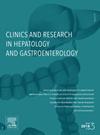Hepatocellular carcinoma risk in ICD-coded non-cirrhotic nonalcoholic fatty liver disease refined by fatty liver index: A nationwide South Korean cohort study
IF 2.4
4区 医学
Q2 GASTROENTEROLOGY & HEPATOLOGY
Clinics and research in hepatology and gastroenterology
Pub Date : 2025-05-08
DOI:10.1016/j.clinre.2025.102612
引用次数: 0
Abstract
Background/Aims
Hepatocellular carcinoma (HCC) is an increasing global health burden, driven by demographic shifts and the growing prevalence of risk factors such as non-alcoholic fatty liver disease (NAFLD), now referred to as metabolic dysfunction-associated steatotic liver disease (MASLD). Despite the majority of NAFLD patients being in the non-cirrhotic stage, there is a notable lack of data on HCC incidence and risk factors, making it challenging to implement effective public health screening and prevention strategies.
Methods
This study conducted a longitudinal analysis of a nationwide cohort of NAFLD patients using big data from the National Health Insurance Service of South Korea to assess HCC incidence and risk factors, focusing on non-cirrhotic patients. NAFLD was identified through ICD-10 codes and refined using a fatty liver index (FLI) score above 30.
Results
A total of 529,811 patients were enrolled. After a washout period, 36,760 patients were newly diagnosed with NAFLD. The incidence rate of HCC per 100,000 person-years was 10.00 in healthy controls and 31.66 in NAFLD patients, further divided into 24.87 in non-cirrhotic NAFLD and 721.5 in cirrhotic NAFLD. In the 1:1 Propensity Score Matched analysis, HCC incidence in non-cirrhotic NAFLD was 24.89 per 100,000 person-years compared to 9.72 in matched healthy controls, yielding an adjusted hazard ratio (HR) of 2.69 (95 % CI 1.33–5.44). Multivariate Cox regression analysis indicated that both cirrhotic and non-cirrhotic NAFLD significantly increased the risk of developing HCC, with additional factors such as age, male sex, and type 2 diabetes. A subsequent analysis of non-cirrhotic NAFLD patients confirmed that advanced age and male sex remained significant risk factors for the development of HCC.
Conclusions
This study demonstrates that non-cirrhotic NAFLD patients, particularly males and those aged 70–79 years, have a significantly increased risk of HCC compared to healthy controls. Given the applicability of NAFLD concepts to MASLD, our findings could provide insights for identifying high-risk individuals within the MASLD spectrum and developing effective strategies to reduce the risk of HCC.

由脂肪肝指数确定的icd编码的非肝硬化非酒精性脂肪性肝病的肝细胞癌风险:一项全国性的韩国队列研究
背景/目的:受人口结构变化和非酒精性脂肪性肝病(NAFLD)(现在称为代谢功能障碍相关脂肪性肝病(MASLD))等危险因素日益流行的推动,肝细胞癌(HCC)是一种日益严重的全球健康负担。尽管大多数NAFLD患者处于非肝硬化阶段,但HCC发病率和危险因素的数据明显缺乏,这使得实施有效的公共卫生筛查和预防策略具有挑战性。方法:本研究使用韩国国民健康保险服务的大数据对全国NAFLD患者队列进行纵向分析,以评估HCC发生率和危险因素,重点关注非肝硬化患者。通过ICD-10代码识别NAFLD,并使用脂肪肝指数(FLI)评分大于30进行细化。结果共纳入529,811例患者。在洗脱期后,36760名新诊断为NAFLD的患者。健康对照组的HCC发病率为每10万人年10.00例,NAFLD患者为31.66例,非肝硬化NAFLD患者为24.87例,肝硬化NAFLD患者为721.5例。在1:1倾向评分匹配分析中,非肝硬化NAFLD的HCC发病率为24.89 / 10万人-年,而匹配的健康对照组为9.72 / 10万人-年,调整后的风险比(HR)为2.69 (95% CI 1.33-5.44)。多因素Cox回归分析表明,肝硬化和非肝硬化NAFLD均显著增加发生HCC的风险,其他因素如年龄、男性和2型糖尿病。随后对非肝硬化NAFLD患者的分析证实,高龄和男性仍然是HCC发展的重要危险因素。本研究表明,与健康对照组相比,非肝硬化NAFLD患者,尤其是男性和年龄在70-79岁之间的NAFLD患者发生HCC的风险显著增加。鉴于NAFLD概念对MASLD的适用性,我们的研究结果可以为识别MASLD谱系中的高危个体和制定有效的策略来降低HCC的风险提供见解。
本文章由计算机程序翻译,如有差异,请以英文原文为准。
求助全文
约1分钟内获得全文
求助全文
来源期刊

Clinics and research in hepatology and gastroenterology
GASTROENTEROLOGY & HEPATOLOGY-
CiteScore
4.30
自引率
3.70%
发文量
198
审稿时长
42 days
期刊介绍:
Clinics and Research in Hepatology and Gastroenterology publishes high-quality original research papers in the field of hepatology and gastroenterology. The editors put the accent on rapid communication of new research and clinical developments and so called "hot topic" issues. Following a clear Editorial line, besides original articles and case reports, each issue features editorials, commentaries and reviews. The journal encourages research and discussion between all those involved in the specialty on an international level. All articles are peer reviewed by international experts, the articles in press are online and indexed in the international databases (Current Contents, Pubmed, Scopus, Science Direct).
Clinics and Research in Hepatology and Gastroenterology is a subscription journal (with optional open access), which allows you to publish your research without any cost to you (unless you proactively chose the open access option). Your article will be available to all researchers around the globe whose institution has a subscription to the journal.
 求助内容:
求助内容: 应助结果提醒方式:
应助结果提醒方式:


